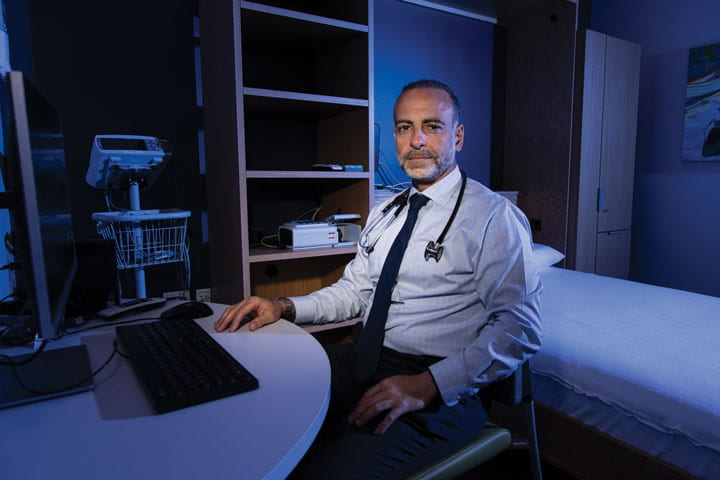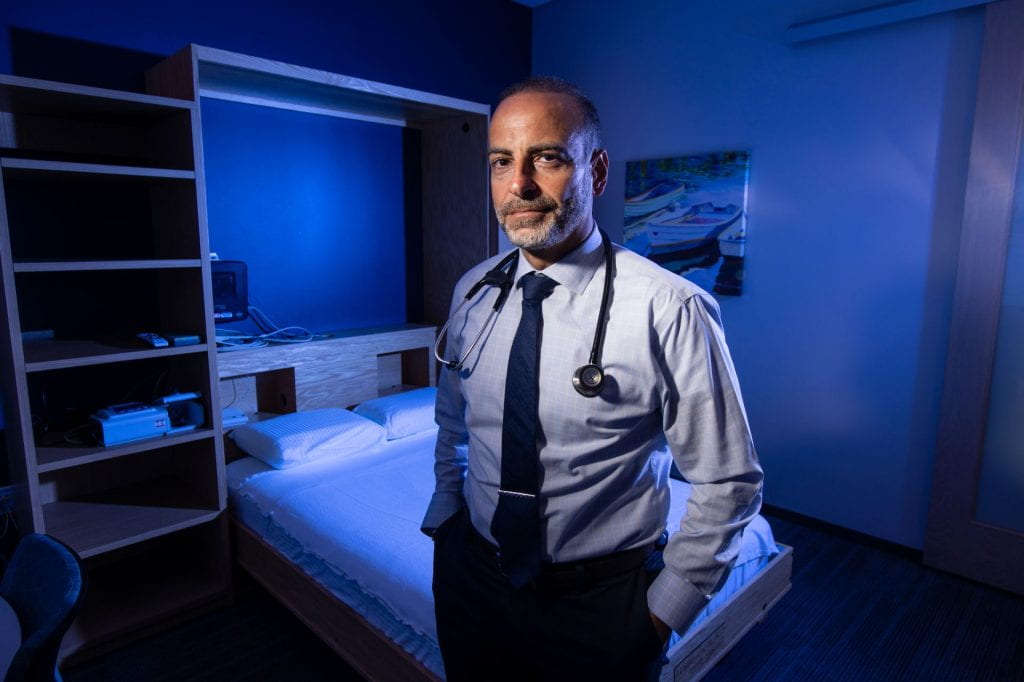
Sweet Dreams
UCI Health’s Sleep Center can help myriad disorders
Insomnia. Sleepwalking. Acting out during sleep. Excessive daytime drowsiness. Narcolepsy. Restless leg syndrome. Snoring. Different types of sleep apnea. Troublesome jet lag. Dr. Rami Khayat, a UCI professor of clinical medicine who directs UCI Health’s Sleep Center in Newport Beach, sees it all.
“The great thing about our clinic is that it’s truly comprehensive. A lot of sleep centers focus on one disorder – for example, apnea – but not here,” he says. “We can help everyone.”
The Sleep Center, which opened in 2018, is the only academic clinic of its kind in Orange County. Treatment for new patients typically starts with a one-hour evaluation in which sleep problems and the person’s sleep environment and routines are discussed.
Doctors also evaluate the patient’s airways, review medical records and suggest possible treatments. Many people end up taking home medical-grade monitoring kits or research-backed smartwatches that track vital signs and offer clinicians insight into sleep disturbances. Some bed down for observation overnight in the eightbay sleep lab.

A typical patient undergoing a sleep study in the Sleep Center will spend a night wearing numerous sensors and leads while being monitored by a sleep professional. “But it’s not uncomfortable,” Khayat assures.
About half of the center’s patients have sleep apnea, a breathing condition that affects nearly 30 percent of U.S. adults. Insomnia is the second-most-common disorder.
Once a sleep diagnosis is made, typical treatments range from behavior modifications and counseling to breathing masks or surgically implantable devices.
For patients with central sleep apnea, a rare form of the nighttime breathing problem, UCI Health offers Remede, an FDA-approved implanted phrenic nerve stimulator that works similar to a pacemaker, Khayat says.
The Sleep Center is one of the few places in the region that services and programs the implantable device for central sleep apnea, though patients who will benefit from Remede are carefully selected. The center also provides an implantable hypoglossal nerve stimulator for the more common condition, obstructive sleep apnea. UCI is one of the largest centers in California offering this therapy for OSA.
By far the most common treatment for apnea remains a continuous positive airway pressure mask, which patients wear at night. Sleep Center clinicians educate patients on how to use and clean C-PAPs.
“Sometimes people say C-PAPs are an ordeal to clean and maintain,” Khayat says. “A big reason, though, is that patients often get little attention and support from providers and vendor companies. Patients tell us that they sometimes just receive the device in the mail, and they don’t know what to do with it. So here we do a lot of support and frequent visits for our patients to adjust to using these things. We try to make it as easy as possible.”
In many cases, people benefit from behavioral health therapy or coaching with a variety of tools to improve their sleep. The good news is that there is almost always a way for the Sleep Center to help, Khayat says, and most often without medications.
“It takes motivation on the patient’s part, but we have very health-literate and -conscious patients,” he says. “They truly want to understand what they can do to get the most out of sleep.”
“It takes motivation on the patient’s part, but we have very health-literate and -conscious patients. They truly want to understand what they can do to get the most out of sleep.”
But many people suffer too long before they seek help. If on most mornings you don’t wake up refreshed or if you’re repeatedly falling asleep well before typical bedtime, Khayat says, it may be time for an appointment.
He adds that some people just accept that they fall asleep during the day or wake up a lot at night – “or that they get insomnia, which is very common. Something like 40 percent of the population suffers from it. But just because it’s common doesn’t mean it’s normal. And once they come in, the vast majority of patients will experience significant to complete relief from most of these disorders.”
In fact, Khayat says, about 70 percent of the center’s insomnia patients see marked improvement after completing a behavioral therapy program – to the point where sleeplessness is no longer interfering with their lives. The benefits of this program, he adds, are long-lasting and do not require medications.
“So many people are surprised,” he says. “They wish they’d come in sooner.”
Tips for Dozing Well
According to the UCI Health Sleep Center, almost anyone will benefit from these simple guidelines to improve slumber:
- Maintain a consistent sleep-wake schedule, even on the weekends.
- Create a good sleep environment – dark and quiet, if possible.
- Turn off screens 30 minutes before you get in bed. Exposure to these light sources may disrupt your body’s natural circadian rhythm, the light/dark sensors that tell your body it’s time to sleep. Also, turn off phones or other devices that may disrupt your sleep.
- If you wake during the night and can’t get back to sleep for 20 or more minutes, get up and read or sit quietly in another room. Get back in bed only once you feel tired again. If you don’t fall asleep after 20 minutes, repeat. The idea is to train your body to associate sleep – not tossing and turning – with your bed.